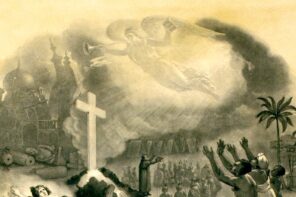“Institutions do not usually make for the most thrilling reading,” John Fea writes at the beginning of his impressive, massively detailed institutional history of the American Bible Society. Many readers, myself included, might be aware of the critical importance of the ABS in the nineteenth century, but probably thought it had trailed off into insignificance sometime in the twentieth. That’s far from the case. A major accomplishment of Fea’s work is to trace that entire history, and to do so not as an apologist but as a professional historian. The fact that Fea was first contacted to write this in December 2013, and has produced this definitive commissioned history less than two and a half years later, speaks to a scholar whose drive for writing and ceaseless energy is well illustrated every day on his blog The Way of Improvement Leads Home.
The book has already received two thoughtful and extensive reviews from the scholars Elesha Coffman and Candy Gunther Brown, at Religion in American History. In hopes of furthering the dialogue, what I’ve written here supplements rather than repeats some of what they’ve said there.

The Bible Cause: A History of the American Bible Society
John Fea
Oxford University Press
April 5, 2016
For the first century or so of its existence, it functioned on a model of federalism—the central organization did its work through local auxiliaries, which did the actual distributing of the sacred texts. The ABS produced cheap, text-only Bibles, sold at cost and distributed through “branch societies,” and thus undercut competitors. If you wanted notes, commentary, or maps, you would have to look elsewhere; the ABS focused on sola scriptura, with the faith that the words alone, guided by the Holy Spirit, would effect transformations in the lives of individuals.
If there’s one thing that American Protestants are good at, it is mass producing and distributing religious material, be it Bibles (in this case), pamphlets, tracts, images of a white dude who is supposed to be Jesus, and so on and on. Numbers appear through this book, sometimes with numbing frequency and volume. Thousands of Bibles in the early years of the ABS; tens of thousands some decades later; millions and millions through the course of the twentieth century.
The numbers document the stunning capacity of the ABS to flood the zone with Scriptures. Through the book, the ABS accomplished exactly that on the western frontier in the early nineteenth century, Union soldiers’ camps during the Civil War, the Levant in the early twentieth century, Japan after World War Two, and with contemporary translations such as the Good News Bible in the 1970s. The tonnage is so impressive that recent leaders of the ABS have complained that an emphasis on the volume of material distributed might distract from an emphasis on actual engagement with the text.
And the text itself—without notes or commentaries, and with nothing other than the voice of the Holy Spirit leading the reader—was, and is, fundamental to the faith energizing the ABS. If that sounds like the ABS is therefore an uber-Protestant organization, you would be correct. Always interdenominational, the ABS was closely associated with “the Protestant establishment” for much of its career. More recently, it has aligned itself with evangelical Protestants, who support the historic aims of the ABS in being an organization central to the cause of making America a Christian nation. While always willing to work with anyone interested in Bible promotion, the ABS, as Fea explains, “has always gravitated towards the particular expression of Christianity that its board and staff believed to be the moral guardians of America’s status as a Christian nation.”
A particularly fascinating narrative line of the book is about the ABS’s key role in “innovation, both in American Christianity and the nation as a whole.” Fea details these through the course of the narrative, including steam-power presses, Braille Bibles, talking Bibles, direct marketing of Bibles, “postage seals, music videos, and digital scripture products.” Yes, there’s an app for that. Moreover, the ABS was key to two new translations of the Bible—Today’s English Version and the Contemporary English Version—which rendered Biblical texts in contemporary language.
The Civil War was an acid test for the nonpartisan ABS. By one measure, their method continued to work its wonders. By the end of 1861, the Society claimed success in printing 7,000 pocket New Testaments per day to soldiers; by the end of the War, the ABS claimed to have distributed well over 3,000,000 Bibles to soldiers (including those who had been captured and imprisoned) and civilians. A southern version of the ABS loved to recount the stories of heroic bible-carriers breaking Union naval and land blockades to distribute the holy texts.
“The writing of an institutional history requires that the historian use the institution’s records as his or her major primary source. This can lead to rich material that might otherwise be inaccessible. It can also, and inevitably, push the work in certain directions.”
During this period, and through all periods covered here, the ABS assumed that the distribution of the text would work its magic. The logic is the same as in how the market is viewed in classical liberalism in economics. The Holy Spirit works as the invisible hand, activating the power that the text, like the market, produces. Of course (and as Fea knows), reality has a way of being more complicated. For example, Confederate soldiers, who were in need of so many more basic things (food, shoes, and other necessities), sometimes let Bible distributors know how much they valued their product by using the pages to deposit wads of tobacco, or to line sinks in army camps. The limited place of Bibles for some northern soldiers was evident as well. When one Union soldier lost his Bible at the Battle of Shiloh, he simply hoped that “the man that took it will make better use of it than I did.” Ultimately, religion might be a good thing, another soldier said, but there was, he added, “such a thing as having too damn much of it.” Broadening the sources, then, casts some of the ABS’s self-reported successes in a different light.
The promise of an institutional history such as this is the depth of the archives available, made more so here by massive research conducted in an earlier era by a scholar who had planned, but failed, to produce a volume commemorating the 150th anniversary of the organization. The writing of an institutional history, of course, requires that the historian use the institution’s records as his or her major primary source. This can lead to rich material that might otherwise be inaccessible. It can also, and inevitably, push the work in certain directions.
A work of history is often about what its sources are about. And when the sources come directly from the archives of the institution, the language of the text inevitably recapitulates some of that voice. Fea places his story in a broad national context. He does so particularly effectively in earlier portions of the book, which cover the ABS’s early glory years. He ties the aims of the ABS to the broader culture of early nineteenth-century Federalist sympathizers who created national organizations in part to unite the new Republic and create the “Christian nation” they longed to see, but knew was not there, at least not yet.
The historical distance from the subject lessens at precisely the point when humanizing anecdotes appear. The emotional narratives of people collapsing in joy at receiving the promised texts, cherishing and never misusing them and so forth, raise questions of interpretation difficult to answer from within the requirements of the genre of institutional history. The answers that might emerge would have to come from questions and interpretive choices that necessarily breach the historical decorum required to produce an institutional history.
“… the goal has been to spread the gospel through distributing Bibles, and ‘to build a Christian civilization.'”
Put more simply, you are not supposed to bash the institution you have been commissioned to write a history about. Except that, actually it is possible. Fea critiques the ABS skillfully in parts of the text. For example, Fea describes the “Colored Agency” that emerged in the late nineteenth century. It was to replace a failed local auxiliary system that by definition could not work to supply Bibles to African Americans. But in doing so, the ABS “also revealed its willingness to embrace the status quo of a ‘separate but equal’ America.” I would say “separate and unequal,” but the point is well taken.
Another example comes from the passages in which Fea traces the various permutations the ABS has undergone as an organization. It has been all societies for all people at various times—a benevolent society in the nineteenth century, a service organization for much of the twentieth century, a business always because it sells Bibles, and today branding itself as a “ministry,” modeling the language of contemporary evangelicals. Throughout, and regardless of the type of organization it conceived itself as, the goal has been to spread the gospel through distributing Bibles, and “to build a Christian civilization.”
At its 150th anniversary meeting in 1966, Billy Graham spoke on the need to “Return to the Bible,” and endorsed the ABS’s historic raison d’être of distributing scriptures. The ABS subsequently moved into a new building in New York City, and resumed its work: “Scriptures needed to be distributed. Morality needed to be restored. And the United States needed to be returned to its biblical heritage.” Into the 1970s, the ABS sought to “reassert its historical connection to Christian nationalism” by realigning itself away from mainstream Protestants and more towards conservative evangelicals. This is Fea at his best—narrating a story effectively, and implicitly interpreting it precisely by adopting the voice of the institution’s founders and followers but retaining a gently ironic distance in style.
The larger philosophical question raised here by works such as these comes down to this: to what degree should historians reflect and explain the views of their subjects, and to what degree should we step entirely outside their frame, and deconstruct their view, or show how much they might have worked against their own purposes? It’s a fundamental debate in American religious studies right now, one often pitting historians and religious studies scholars sporting philosophically opposed approaches. Fea is decidedly in the historians’ camp here. Let the argument continue. In the meantime sound historical scholarship such as is evident in this work is fundamental to having anything to discuss in the first place.





